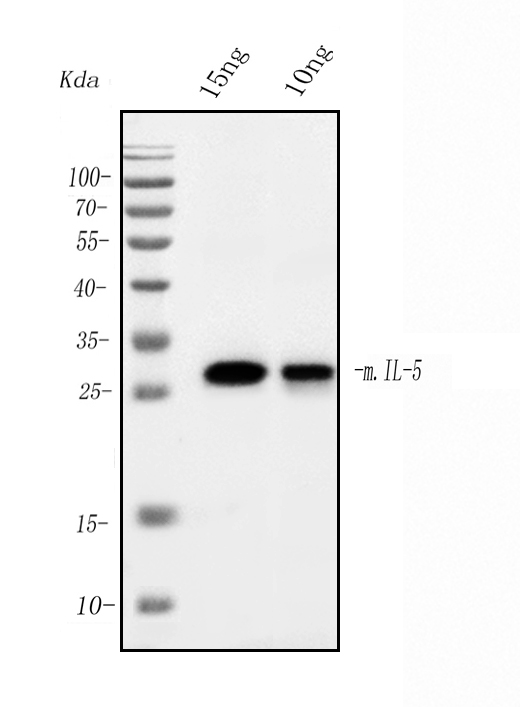Anti- IL-5 Monoclonal Antibody
- SPECIFICATION
- CITATIONS
- PROTOCOLS
- BACKGROUND

Application
| WB |
|---|---|
| Primary Accession | P05113 |
| Host | Rat |
| Isotype | Rat IgG1, κ |
| Reactivity | Mouse |
| Clonality | Monoclonal |
| Format | Lyophilized |
| Description | Anti- IL-5 Monoclonal Antibody . Tested in WB applications. This antibody reacts with Mouse. |
| Reconstitution | Add 0.2ml of distilled water will yield a concentration of 500 µg/ml. |
| Gene ID | 3567 |
|---|---|
| Other Names | Interleukin-5, IL-5, B-cell differentiation factor I, Eosinophil differentiation factor, T-cell replacing factor, TRF, IL5 |
| Calculated MW | 15 kDa |
| Application Details | Western blot, 0.25-0.5 µg/ml, Mouse |
| Protein Name | Interleukin-5 |
| Contents | PBS, pH 7.0. Contains no stabilizers or preservatives |
| Clone Names | Clone: AFIH-9 |
| Immunogen | Mouse partially-purified T cell clone supernatant |
| Purification | Immunogen affinity purified. |
| Storage | Store at -20°C for one year. For short term storage and frequent use, store at 4°C for up to one month. Avoid repeated freeze-thaw cycles. |
| Name | IL5 |
|---|---|
| Function | Homodimeric cytokine expressed predominantly by T-lymphocytes and NK cells that plays an important role in the survival, differentiation, and chemotaxis of eosinophils (PubMed:2653458, PubMed:9010276). Acts also on activated and resting B-cells to induce immunoglobulin production, growth, and differentiation (By similarity). Mechanistically, exerts its biological effects through a receptor composed of IL5RA subunit and the cytokine receptor common subunit beta/CSF2RB (PubMed:1495999, PubMed:22528658). Binding to the receptor leads to activation of various kinases including LYN, SYK and JAK2 and thereby propagates signals through the RAS-MAPK and JAK-STAT5 pathways respectively (PubMed:7613138). |
| Cellular Location | Secreted. |
| Tissue Location | Present in peripheral blood mononuclear cells. |

Thousands of laboratories across the world have published research that depended on the performance of antibodies from Abcepta to advance their research. Check out links to articles that cite our products in major peer-reviewed journals, organized by research category.
info@abcepta.com, and receive a free "I Love Antibodies" mug.
Provided below are standard protocols that you may find useful for product applications.
Background
This gene encodes a cytokine that acts as a growth and differentiation factor for both B cells and eosinophils. The encoded cytokine plays a major role in the regulation of eosinophil formation, maturation, recruitment and survival. The increased production of this cytokine may be related to pathogenesis of eosinophil-dependent inflammatory diseases. This cytokine functions by binding to its receptor, which is a heterodimer, whose beta subunit is shared with the receptors for interleukine 3 (IL3) and colony stimulating factor 2 (CSF2/GM-CSF). This gene is located on chromosome 5 within a cytokine gene cluster which includes interleukin 4 (IL4), interleukin 13 (IL13), and CSF2. This gene, IL4, and IL13 may be regulated coordinately by long-range regulatory elements spread over 120 kilobases on chromosome 5q31. [provided by RefSeq, Jul 2013]
If you have used an Abcepta product and would like to share how it has performed, please click on the "Submit Review" button and provide the requested information. Our staff will examine and post your review and contact you if needed.
If you have any additional inquiries please email technical services at tech@abcepta.com.













 Foundational characteristics of cancer include proliferation, angiogenesis, migration, evasion of apoptosis, and cellular immortality. Find key markers for these cellular processes and antibodies to detect them.
Foundational characteristics of cancer include proliferation, angiogenesis, migration, evasion of apoptosis, and cellular immortality. Find key markers for these cellular processes and antibodies to detect them. The SUMOplot™ Analysis Program predicts and scores sumoylation sites in your protein. SUMOylation is a post-translational modification involved in various cellular processes, such as nuclear-cytosolic transport, transcriptional regulation, apoptosis, protein stability, response to stress, and progression through the cell cycle.
The SUMOplot™ Analysis Program predicts and scores sumoylation sites in your protein. SUMOylation is a post-translational modification involved in various cellular processes, such as nuclear-cytosolic transport, transcriptional regulation, apoptosis, protein stability, response to stress, and progression through the cell cycle. The Autophagy Receptor Motif Plotter predicts and scores autophagy receptor binding sites in your protein. Identifying proteins connected to this pathway is critical to understanding the role of autophagy in physiological as well as pathological processes such as development, differentiation, neurodegenerative diseases, stress, infection, and cancer.
The Autophagy Receptor Motif Plotter predicts and scores autophagy receptor binding sites in your protein. Identifying proteins connected to this pathway is critical to understanding the role of autophagy in physiological as well as pathological processes such as development, differentiation, neurodegenerative diseases, stress, infection, and cancer.


